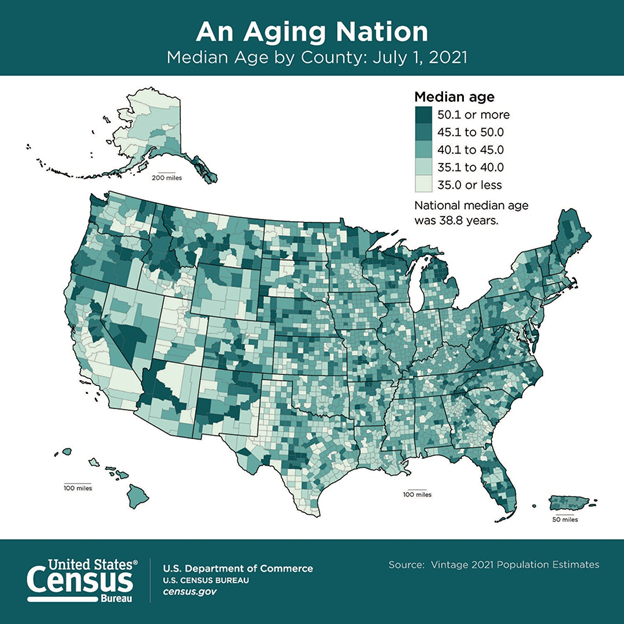Arizona is getting older according to recent U.S. Census Bureau 2021 population estimates, but then so is the rest of the nation. The median age in Arizona for 2021 increased to 38.6 years, just below the U.S. at 38.8 years. (Median age is the point in which one-half the population is older and one-half is younger.) Utah remained the youngest state in the nation with a median age of 31.8 years. Maine was once again the oldest state with a median age of 44.7 years even though it was the only state to have a slight decrease in age.
Over half the counties or county equivalents in the nation experienced an increase in median age between 2020 and 2021. Nearly every county in Arizona had increases in median age, save Pinal and La Paz, which were unchanged. Median age ranged from 32.2 years in Coconino County to 58.0 years in La Paz County. Four counties, La Paz (58.0), Yavapai (55.2), Mohave (53.2), and Gila (50.9), had a median age of 50 or older in 2021. This was still not as old as some places in the U.S. as six counties (including two in neighboring New Mexico) had median ages greater than 60.
Bankruptcy filings in Arizona stood at 825 for June, a decrease of 6.4% from the same month last year. Until June, there had been double-digit decreases every month this year. Both Chapter 11 (reorganization) and Chapter 13 (individual debt adjustment) filings had increases over the month and were higher than the same month last year. Year-to-date, June bankruptcies were lower statewide and in all three offices with reductions of 15.6% in Arizona, 16.5% in the Phoenix office, 9.4% in the Tucson office and 30.6% in the Yuma office. Two counties in the state reported more bankruptcies year-to-date than last year, Navajo and Graham while two others, Cochise and Greenlee had the same number as this period last year. The Phoenix office includes Apache, Coconino, Gila, Maricopa, Navajo, and Yavapai counties. The Tucson office oversees Cochise, Graham, Greenlee, Pima, Pinal, and Santa Cruz counties, while the Yuma office represents La Paz, Mohave, and Yuma counties.
The U.S. trade deficit continued to decrease in May, down $1.1 billion to $85.5 billion for the month after a substantial decrease in April. Exports of goods and services rose $3.0 billion in May to $255.9 billion. Imports increased by $1.9 billion to $341.4 billion. Year-to-date, the deficit was 38.4% higher than the same period a year ago based on the July 7 joint U.S. Census Bureau and U.S. Bureau of Economic Analysis release.
In June U.S. nonfarm payroll employment increased by 372,000 on a seasonally adjusted basis according to the July 8 U.S. Bureau of Labor Statistics release. The average increase of the prior three months was 383,000. Professional and business services, leisure and hospitality as well as health care posted the largest increases in employment for the month. This was the fourth month in a row that unemployment rate stayed at 3.6%. Both the labor force participation rate (62.2%) and the employment to population ratio (59.9%) were little changed over the month.
Real GDP in Arizona decreased at an annual rate of 2.5% in the first quarter 2022 compared to a decrease of 1.6% for the nation. Only a handful of states had positive changes in GDP for the first quarter with percent change in real GDP ranging from 1.2% in New Hampshire to -9.7% in Wyoming. Mining, quarrying, and oil and gas extraction was the leading contributor to the decrease in Wyoming and the four other states with the largest decrease in real GDP according to the June 30 Bureau of Economic Analysis release. Also noted was that starting in September quarterly statistics for state GDP and state personal income will be released at the same time.
Inflation continued to increase in June, moving to 9.1%, the highest rate since November 1981 based on the Consumer Price Index July 13 release from the U.S. Bureau of Labor Statistics. Energy costs had a 12-month change of 41.6%, the largest increase for the energy index since April 1980. Food prices rose 10.4% percent over the same period last year. The seasonally adjusted monthly figure increased 1.3% in June. Price escalations were broad-based though energy costs contributed almost half of the increase as gasoline prices increased 11.2% over the month. The index for all items less food and energy ticked up to 0.7% over the month after staying at 0.6% for the previous two months.
Author: Valorie H. Rice is the Senior Business Information Specialist at the Economic and Business Research Center (EBRC) in the University of Arizona’s Eller College of Management.







